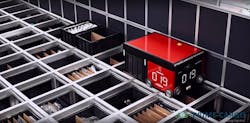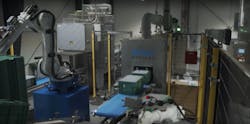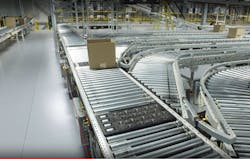Dark Factories: Science Fiction or Reality?
Advancements in automation, robotics, sensors, artificial intelligence and machine learning have led to the potential for self-contained, self-servicing production lines and warehouses. “Lights-out” or “dark” facilities have potential, but is the technology robust and advanced enough for this concept to become a reality?
For a supply chain perspective, Machine Design spoke with Guy Courtin, vice president of Industry and Advanced Technology at digital supply chain solutions company Tecsys Inc. For the last two decades, Courtin has spent time in leadership roles for supply chain solution providers as well as spending time as an industry analyst covering the manufacturing and supply chain space.
READ MORE: Supply Chain Outlook: As Chaos Eases, Growth Can Return
While automation is nothing new in the factory—think back to the late 1700s when machines helped produce clothing, Courtin reminds us—today’s automation is much more sophisticated and often humans are not needed. Among the benefits of a fully automated dark factory, Courtin says: “Robots don’t require breaks or get tired. Conceivably you could run the facility 24/7. Robots don’t need heat in the winter or air conditioning in the summer. They don’t require lights; they can see in the dark. Certain safety precautions are not necessary…and robots don’t go on bathroom breaks or go on strike.”
When asked how virtual robots can better integrate with existing software and systems, and what role they play in the dark factory concept, Courtin says that with any remotely controlled or autonomous robot, the increased computation power available locally as well as the advances in cloud technology, Wi-Fi, 5G and other communication protocols allow for deeper control of this hardware. “These technologies can make autonomous robotics more of a reality for a dark factory,” he says.
READ MORE: Using AI and Edge Computing for Supply Chain Engineering
Overcoming Technical Challenges
Connectivity is a concern, and it is important to address that aspect to ensure as close to full-time uptime as possible. Courtin reiterates the importance of robust supporting technology: “How stable is your Wi-Fi or 5G network? Do you need to have redundancy within your factory to ensure the systems stay up? If your technology requires on-premises solutions, then you need to ensure you have the right servers within the factory.”
As with all technologies, there are limits. “The main limitation I see currently is more associated with cost,” Courtin says. “If we had unlimited budgets, then we could have all the robotic toys we wanted. But we have to show some level of ROI.”
“Other limits are in some manipulation that humans are still vastly better at. For example, picking items off a warehouse shelf,” Courtin says. “We have robotic picking arms, but humans are still much better at this—and more cost-effective.”
Consider Potential Risks
Courtin reminds us that no technology is without some risk, and one such risk is over-reliance on automation to operate a dark factory. “What happens if there is a power outage or one of the robots goes down?” he asks. “Does this stop my entire process? What are my redundancies when it comes to robotics?”
Another risk to consider is labor strife. He says it is hard to imagine flipping a switch and going from a traditional factory to a fully automated dark factory overnight. “How does labor react when they see more automation? Are there potential issues with labor, unions, etc.? I have seen challenges in selling automation in areas with strong unions as they will oppose such an investment,” Courtin notes.
Certain jobs will be lost, he acknowledges, while noting employment should remain steady. “Will certain roles in the factory go away? Absolutely. But others will emerge,” he says. “I believe that automation will continue to be complementary to labor…It will certainly replace specific jobs.
“But I think where the chasm is between that sort of science fiction and the reality is there [are] still a tremendous [number] of jobs within these facilities that humans are still better equipped to do and that we still, as humans ourselves, recognize that the humans are better suited to do those jobs,” he adds.
Expect Change Management
One of the main areas to focus on, according to Courtin, is how a fully automated facility could potentially impact the rest of the supply chain. “We covered how it will impact labor, but what about other parts of the system?” he says.
“If I increase my throughput in my factory, can my transportation node handle the potential increased volumes of finished goods? Can my suppliers keep up if my production increases two times or three times? I might be optimizing one node of my supply chain, but what is the knock-on effect to the rest of my supply chain?”
In Courtin’s dealings with factory and warehouse operators, he says he realized very quickly that some of the processes and procedures are almost ritualistic. So, if a technology as disruptive as robotics is introduced, there will inevitably be change management needs.
From a personnel perspective as well as a process and a flow perspective, Courtin says it must be considered: “You have a system that is…chugging along. Whether it’s great or not, it’s doing its job. And, also, now you’re introducing…a physical machine, a robot, to do something. So that’s what I would caution folks.”
It does not mean that people should not look at bringing more automation into their facility, he notes, but it does need to be considered. “It’s not just bringing a robot in, solve Problem X, increase efficiency … great, done. It’s what happens across the whole system,” Courtin says.
Parallel Paths for the Future
At the end of the day, a robot is plastic, steel, wires, glass and rubber, Courtin notes. When put together, “mechanically it could do a lot of great things,” he says, “but if I don’t have some kind of control, some kind of software brain that tells it what to do, then it’s just a statue.”
Let’s look at these parallel paths. “From a mechanical perspective—and I am certainly not a mechanical engineer, so I apologize to offend anybody out there who is—but from a mechanical engineering perspective, I still think there are…tremendous opportunities to push the envelope as to what the physical robots can do,” he says, noting manipulation of material, camera technology and visual systems.
He says he sees investments on that track with continuous process improvements.
READ MORE: Computer Vision Transforms Production and Quality Control
The biggest leaps that will influence the entire system, however, are around the software, Courtin believes. “How do we leverage things like smarter or artificial intelligence? How do we leverage things such as much more or much more plentiful data?”
Access to more relevant data is the key. How will companies generate and leverage the data? And because these facilities are not based on one technology, they are going to have multiple different hardware and software for multiple different robots. “So, we need some kind of connective tissue that now allows interoperability to happen between all these solutions to make a dark factory feasible, to make a dark warehouse more feasible,” Courtin says.
Give Up Control to Gain Control
“All of us software providers, even the integrators and the consultants, we’re all trying to become that player that controls all of it. Why? Because if I control all of that, commercially, that puts me in a very strong position,” Courtin says.
Of course, each individual node doesn’t necessarily want someone else to control what they do. “So, all of a sudden, we have this conflict where…we want to see some kind of hierarchy, we want to see some kind of digital solution that can help integrate and control all this. But each player has to be willing to give up some control to have this happen.
“And I have yet to see that happen across the board. Unless, of course, you go in and someone dictates it, but they do it grudgingly. So…when I look ahead…I think that’s what I'm seeing as we continue to evolve and pour resources into it,” Courtin says. “And I think that’s incredibly exciting.”
READ MORE: 5 for Friday: A Connected Plant is Essential for the Future
About the Author
Sharon Spielman
Technical Editor, Machine Design
As Machine Design’s technical editor, Sharon Spielman produces content for the brand’s focus audience—design and multidisciplinary engineers. Her beat includes 3D printing/CAD; mechanical and motion systems, with an emphasis on pneumatics and linear motion; automation; robotics; and CNC machining.
Spielman has more than three decades of experience as a writer and editor for a range of B2B brands, including those that cover machine design; electrical design and manufacturing; interconnection technology; food and beverage manufacturing; process heating and cooling; finishing; and package converting.
Email: [email protected]
LinkedIn: @sharonspielman
Facebook: Machine Design
YouTube: @MachineDesign-EBM





